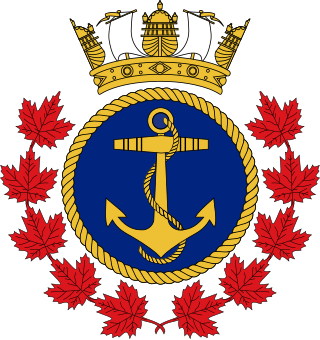Related Research Articles

The Royal Canadian Navy is the naval force of Canada. The RCN is one of three environmental commands within the Canadian Armed Forces. As of 2023, the RCN operates 12 frigates, four attack submarines, 12 coastal defence vessels, eight patrol-class training vessels, two offshore patrol vessels, and several auxiliary vessels. The RCN consists of 8,400 Regular Force and 4,100 Primary Reserve sailors, supported by 3,800 civilians. Vice-Admiral Angus Topshee is the commander of the Royal Canadian Navy and chief of the Naval Staff.

HMS Uganda was a Second World War-era Fiji-class light cruiser launched in 1941. She served in the Royal Navy during 1943 and 1944, including operations in the Mediterranean, and was transferred to the Royal Canadian Navy as HMCS Uganda in October 1944. She served in the Pacific theatre in 1945 and was put into reserve in 1947. When she was reactivated for the Korean War in 1952 she was renamed HMCS Quebec. She was decommissioned for the last time in 1956 and scrapped in Japan in 1961.

The Royal Canadian Sea Cadets is a Canadian national youth program sponsored by the Canadian Armed Forces and the civilian Navy League of Canada. Administered by the Canadian Forces, the program is funded through the Department of National Defence, with the civilian partner providing support in the local community. Cadets are not members of the Canadian Armed Forces.
Several Canadian naval units have been named HMCS Vancouver. One was named for the explorer George Vancouver, the others after the city of Vancouver.
Several Canadian naval units have been named HMCS Montreal.
Four Canadian naval units have been named HMCS Ottawa.
Several Canadian naval units have been named HMCS Ville de Quebec.

HMCS Ontario can refer to several ships:
Several Canadian naval units have been named HMCS Chaudiere.

HMCS Carleton is a Canadian Forces Naval Reserve Division (NRD) located in Ottawa, Ontario, Canada. Dubbed a stone frigate, HMCS Carleton is a land-based naval training establishment crewed by part-time sailors and also serves as a local recruitment centre for the Canadian Forces Naval Reserve. It is one of 24 naval reserve divisions located in major cities across Canada.
Two Canadian naval units have been named HMCS Fraser.
Several Canadian naval units have been named HMCS Margaree.
Two Canadian naval units have been named HMCS Assiniboine.
Several Canadian naval units have been named HMCS St. Laurent.
Several Canadian naval units have been named HMCS Skeena.
Several Canadian naval units have been named HMCS Chaleur.
Several Canadian naval units have carried the name HMCS Champlain:
Rear-Admiral William Moss Landymore, OBE, CD was a Canadian naval officer. Born in Brantford, Ontario, Landymore joined the Royal Canadian Navy in 1936, but spent much of early career training with the Royal Navy. During World War II, Landymore returned to the Royal Canadian Navy and served aboard destroyers in the Battle of the Atlantic, surviving two sinkings. By the end of the war Landymore had taken a series of positions in Ottawa before returning to destroyer command during the Korean War. He was promoted through the ranks eventually becoming the first Commander of Maritime Command. :andymore became embroiled in a public feud with the Minister of National Defence following the Unification of the Canadian Armed Forces and resigned as a result. He died at Halifax, Nova Scotia.
Three ships and a shore establishment of the Royal Navy have borne the name HMS Quebec, after the city of Quebec in Canada: